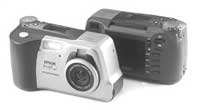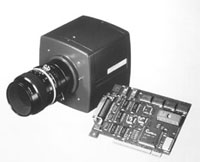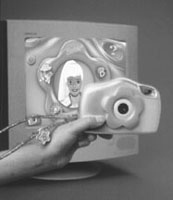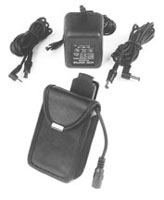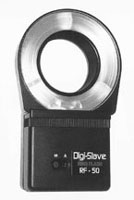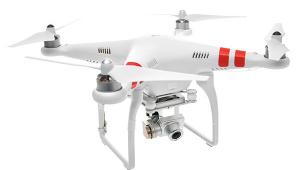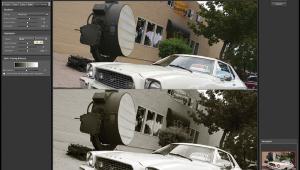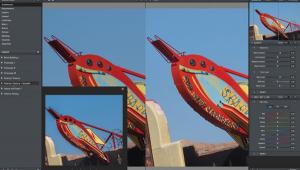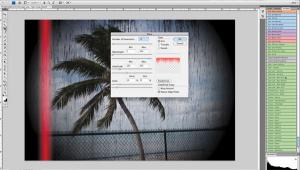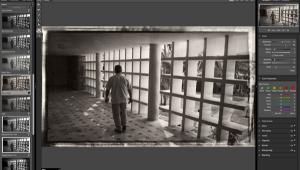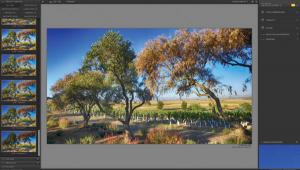Digital Innovations
Digital Cameras Are For Everyone
One of the things I love
most about photography is its democratic nature. Everyone from "happy
snappers" using recyclable cameras to advanced amateurs to professional
photographers creating images for clients enjoy what I believe is the
most satisfying creative pursuit on the planet. These same users can
have just as much fun using digital cameras as they can film-based cameras.
Far from being monolithic, there are different kinds of digital cameras
available for different kinds of users. |
|||
Somewhere between point-and-shoot
and field cameras lies the "bridge" camera. The concept of
a bridge camera is nothing new. Examples abound in film-based cameras
ranging from Nikon's 28Ti to the Contax T2, whose spiritual roots
are found in cameras like the classic Rollei 35. Like their analog cousins,
digital bridge cameras often use a non-SLR design, feature quality lenses,
and offer resolution capabilities similar to some digital field cameras.
If you need relatively high-quality images and a field camera's
price tag seems too high, a bridge camera may be all you need. |
|||
One of the aspects I like the
best about using digital cameras is the instant feedback they provide
to the photographer. By letting young people see the results of their
efforts in minutes instead of hours or even days, this same feature can
be used to inspire interest in photography. Mattel Media creates computer
products aimed at young girls, something their new Barbie Photo Designer
digital camera is sure to do. With a street price under $70, the camera
has the kind of cute styling you would expect from a camera named after
Barbie, including her trademark pink accent color. Barbie Photo Designer
is designed for use only with Windows computers and can store up to six
photographs. The bundled software lets young photographers import their
photographs and paste them into Barbie postcards as well as their own
digital scrapbooks. Is Barbie that popular? Consider this factoid: Somewhere
in the world, two Barbie dolls are sold every second. For more information
about Barbie Photo Designer digital camera, visit Mattel Media's
web site at www.barbie.com. |
|||
It Keeps On Going,
Not. One of the biggest downsides to using digital cameras is
short battery life. Newer cameras have addressed the issue by using NiMH
or Sodium Ion batteries, but LCD preview screens and built-in flashes
gobble batteries faster than a bus load of tourists at a Las Vegas buffet.
Mizco Interna-tional has introduced the new Digi-Power DPS 4000 rechargeable
battery pack that's designed to work with digital cameras from most
leading manufacturers. The DPS 4000 weighs less than 6 oz and its NiMH
batteries provide four times more power than ordinary AA cells. Field
tests conducted with various cameras have shown that the DPS 4000 is capable
of capturing more than 400 high-resolution digital photographs per charge
and the batteries can handle up to 1000 changes. The battery pack costs
less than $40 and includes a leather case that can be worn on a user's
belt. For more information, contact Mizco International at (718) 492-0220. |
|||
You Need Software,
Too. From Down Under comes a software package designed for digital
camera users. IXLA's Digital Camera Suite directly connects with
digital cameras from Casio, Kodak, Ricoh, Epson, HP, Sharp, Olympus, Nikon,
and Fuji. Other camera models are supported via a TWAIN driver that's
included. An Import Assistant guides users through the steps of connecting
a digital camera to a computer, downloading the photographs, then organizing
them into catalogs. A unique feature is the program's ability to
store images back into a camera. The package also lets you create albums,
calendars, invitations, newsletters, greeting cards, as well as presentations
that can include music. A step by step Wizard walks you through the process
of creating your own Internet web pages. The package lets you e-mail digital
photographs anywhere in the world complete with audio, frames, text, and
clip art. IXLA's Digital Camera Suite has an estimated street price
of $29. For more information, contact IXLA at (203) 730-8805 or visit
their web site at www.ixla.com. |
|||
Speaking Of Graphics
Tablets. Wacom Technology Corp. just introduced a new line of
five graphics tablets and four input devices with unique capabilities.
The Intuos 4D Mouse is the first pressure sensitive ambidextrous mouse
that features a thumbwheel control for zooming, navigating, and shuttling
videotape. The Intuos Airbrush is a digital airbrush that is equipped
with a pressure sensitive pen tip for controlling height and a pressure
sensitive fingerwheel for controlling ink flow. The Intuos Lens Cursor
is the first with a rotating crosshair lens making it easier to use in
CAD applications. All of these tools are designed to be used with an Intuos
graphics tablet. The new Intuos tablets have been redesigned and feature
doubled tip sensitivity, 1024 levels of pressure, and a new 9x12"
size. Tablets are available from the (mostly useless) 4x5" size
up to 12x18" for the serious graphics tablet users. For more information,
call Wacom at (800) 922-6613 or visit their web site at www.wacom.com. |
